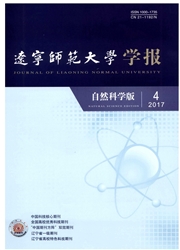

 中文摘要:
中文摘要:
采用水热合成法得到2种Cd(Ⅱ)配合物:[Cd(opth)(H2O)]n(1)和[Cd(phen)(Cl)2]n(2)(opth=邻苯二甲酸;phen=1,10-菲啰啉).采用X-射线单晶衍射确定了配合物的结构,并通过IR,UV-Vis吸收光谱,表面光电压光谱(SPS)进行了物性表征.结构分析表明,配合物(1)是以邻苯二甲酸根为桥配体的具有2D结构的Cd(Ⅱ)配合物,其中金属Cd(Ⅱ)离子为7配位,形成帽型八面体构型;配合物(2)是以Cl%离子为桥配体的具有1D结构的Cd(Ⅱ)配合物,其中金属Cd(Ⅱ)离子为6配位,具有扭曲的八面体构型.通过SPS对2种配合物以及简单Cd(Ⅱ)配合物的光电性能进行了对比分析.结果表明,它们在300~600nm范围内均有一定的光电转换能力,而且配合物的结构、配体的种类和性质对配合物的光电响应均有明显影响.
 英文摘要:
英文摘要:
Two Cd(Ⅱ)complexes [Cd(opth)(H2O)]n(1) and [Cd(phen)(Cl)2]n(2) were synthesized by hydrothermal method(opth=o-phthalate acid,phen=1,10-phenanthroline).And they were characterized by single crystal X-ray diffraction,IR,UV-Vis absorption spectrum and surface photovoltage spectroscopy(SPS).The single-crystal X-ray analysis shows that complex(1) exhibits a 2-D layer structure bridged by opth2-ligands,and the Cd(Ⅱ) ion is seven-coordinate,having a capped octahedral geometry.Complex(2) possesses a 1-D chain bridged by Cl- ainon,and the Cd(Ⅱ) ion is six-coordinate,having a distorted octahedral geometry.The results of SPS indicate that two complexes exhibit photoelectric responses in the range of 300~600 nm,which reveals that they all possess certain photoelectric conversion properties.By comparison,it is found that the structure of complex,the species and property of ligands all affect the intensity and scope of the photoelectric response.
 同期刊论文项目
同期刊论文项目
 同项目期刊论文
同项目期刊论文
 Crystal structure and surface photovoltage of a series of Ni(II) coordination supramolecular polymer
Crystal structure and surface photovoltage of a series of Ni(II) coordination supramolecular polymer 期刊信息
期刊信息
